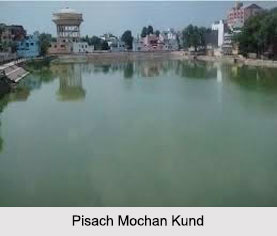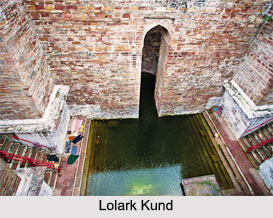 Varanasi is dooted with many holy kunds or ponds. These kunds are thought to be very sacred and are visited by many pilgrims from different places.
Varanasi is dooted with many holy kunds or ponds. These kunds are thought to be very sacred and are visited by many pilgrims from different places.
Importance of Kunds in Varanasi
It is believed by the people that by taking a bath in the holy kunds one can get rid of all the sins and their wishes will get fulfilled. These kunds are associated with many ancient legends and have been built by famous people. Many beautiful temples are located on the banks of these kunds which are mainly dedicated to Lord Shiva and several other deities. Various religious fairs and festivals are also celebrated here by the devotees with much devotion and fervour.
Some of the kunds located here are Pisach Mochan Kund, Gyan Bapi Kund, Lolark Kund and Bakariya Kund.
Pisach Mochan Kund
Pisach Mochan Kund is located in Varanasi, Uttar Pradesh. It is a famous pilgrimage centre for the devotees. There are many beautiful temples located here with idols installed in it. Pisach Mochan Kund has been built in a simple way with stone stairs leading down to the water. It has been built in memory of a demon who was killed by Bhairavnath. After being beheaded the demon had requested Visheswar to allow him to reside on the spot where he was decapitated. The head of the demon has been carved in stone and placed on the top of the ghat by the side of one of the temples. Here, there is a temple of Bhairavnath.
Gyan Bapi Kund
Gyan Bapi Kund known as `well of knowledge` is located in Varanasi. The kund is thought to be resided by Lord Shiva. It is said that once there was no rain in Varanasi for almost twelve years that caused great lot of problems for the people. A sage then taking the trident of Lord Shiva dug up the earth at this spot. This led to the flow of water that relieved the people. Lord Shiva also promised to take up his abode in the well. Thus the well is considered to be very holy and is visited by many pilgrims. There are two small shrines located in the vicinity of the temple. One of them is made of white marble and the other one of stone.
Lolark Kund
Lolark Kund is one of the oldest kunds of Varanasi. It is a rectangular tank of 15m height from below the ground level. It is dedicated to Lord Surya, the Sun God. Many religious festivals are celebrated here. Devotees come here during the festival of Lolark Shasthi to worship the Sun God. Performing pujas and other religious ceremonies here is regarded to be very valuable. Many festivals are also celebrated here on special days. On Lolarka Shasthi, i.e. on the sixth day of second fortnight in lunar month of Bhadrapada devotees throng at the Lolark Kund. Many issueless couples take dip in the holy Lolark Kund with the belief that they would be seen blessed with a child. They also offer fruits or vegetables to the Sun God. The road to Lolark Kund has been well constructed hence making it easy for the devotees to visit the kund.
Bakariya Kund
Bakariya Kund can be seen at the North West corner of the city of Varanasi. It is one of the major tourist attractions in Varanasi. The tank of Bakariya Kund is situated about three hundred yards from the main road, allures the pilgrims for the mythological importance. Now this place is regarded as the archaeological ruins.
Temples near Kunds
There are two temples located on the eastern bank of the kunds. Apart from these, there are many other small Hindu shrines located here. Many idols are installed in these shrines like those of Lord Shiva or Mahadeva, Lord Vishnu, Lord Brahma, Lord Hanuman, Lord Ganesha and others. A very large fair is organised every year at Pisach Mochan kund known as Lota Bhanta. Many people gather to attend the festival.



















